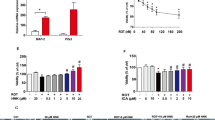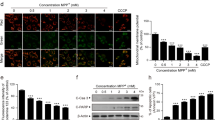Abstract
SIRT1 is a deacetylase with multiple physiological functions by targeting histones and non-histone proteins. It has been shown that SIRT1 activation is involved in neuroprotection in Parkinson’s disease (PD) models. In the present study, we provided direct evidences showing the neuroprotective roles of SIRT1 in dopaminergic neurons. Our data showed that increased expression of SIRT1 plays beneficial roles against MPP+ insults in SH-SY5Y cells and primary dopaminergic neurons, including increased cell viability, reduced LDH release, improved the mitochondrial membrane potential (MMP), and attenuated cell apoptosis. On the contrary, knockdown of SIRT1 further aggravated cell injuries induced by MPP+. Moreover, mutated SIRT1 without deacetylase activity (SIRT1 H363Y) failed to protect dopaminergic neurons from MPP+ injuries. Mechanistically, SIRT1 improved PGC-1α expression and mitochondrial biogenesis. Knockdown of PGC-1α almost completely abolished the neuroprotective roles of SIRT1 in SH-SY5Y cells. Collectively, our data indicate that SIRT1 has neuroprotective roles in dopaminergic neurons, which is dependent upon PGC-1α-mediated mitochondrial biogenesis. These findings suggest that SIRT1 may hold great therapeutic potentials for treating dopaminergic neuron loss associated disorders such as PD.







Similar content being viewed by others
References
Anderson RM, Bitterman KJ, Wood JG, Medvedik O, Sinclair DA (2003) Nicotinamide and PNC1 govern lifespan extension by calorie restriction in Saccharomyces cerevisiae. Nature 423:181–185
Armstrong MJ, Okun MS (2020) Diagnosis and treatment of parkinson disease: a review. JAMA 323:548–560
Braak H, Del Tredici K, Rub U, de Vos RA, Jansen Steur EN, Braak E (2003) Staging of brain pathology related to sporadic Parkinson’s disease. Neurobiol Aging 24:197–211
Brunet A, Sweeney LB, Sturgill JF, Chua KF, Greer PL, Lin Y, Tran H, Ross SE, Mostoslavsky R, Cohen HY et al (2004) Stress-dependent regulation of FOXO transcription factors by the SIRT1 deacetylase. Science 303:2011–2015
Buneeva O, Fedchenko V, Kopylov A, Medvedev A (2020) Mitochondrial dysfunction in Parkinson’s disease: focus on mitochondrial DNA. Biomedicines 8
Chen H, Ji H, Zhang M, Liu Z, Lao L, Deng C, Chen J, Zhong G (2017) An agonist of the protective factor SIRT1 improves functional recovery and promotes neuronal survival by attenuating inflammation after spinal cord injury. J Neurosci 37:2916–2930
Ciron C, Zheng L, Bobela W, Knott GW, Leone TC, Kelly DP, Schneider BL (2015) PGC-1alpha activity in nigral dopamine neurons determines vulnerability to alpha-synuclein. Acta Neuropathol Commun 3:16
Dorsey ER, Bloem BR (2018) The Parkinson pandemic—a call to action. JAMA Neurol 75:9–10
Ellis L, Clauser E, Morgan DO, Edery M, Roth RA, Rutter WJ (1986) Replacement of insulin receptor tyrosine residues 1162 and 1163 compromises insulin-stimulated kinase activity and uptake of 2-deoxyglucose. Cell 45:721–732
Fang X, Ma J, Mu D, Li B, Lian B, Sun C (2020) FGF21 protects dopaminergic neurons in Parkinson’s disease models via repression of neuroinflammation. Neurotox Res 37:616–627
Gaven F, Marin P, Claeysen S (2014) Primary culture of mouse dopaminergic neurons. J Vis Exp e51751
Gleave JA, Arathoon LR, Trinh D, Lizal KE, Giguere N, Barber JHM, Najarali Z, Khan MH, Thiele SL, Semmen MS et al (2017) Sirtuin 3 rescues neurons through the stabilisation of mitochondrial biogenetics in the virally-expressing mutant alpha-synuclein rat model of parkinsonism. Neurobiol Dis 106:133–146
Howitz KT, Bitterman KJ, Cohen HY, Lamming DW, Lavu S, Wood JG, Zipkin RE, Chung P, Kisielewski A, Zhang LL et al (2003) Small molecule activators of sirtuins extend Saccharomyces cerevisiae lifespan. Nature 425:191–196
Huang XZ, Wen D, Zhang M, Xie Q, Ma L, Guan Y, Ren Y, Chen J, Hao CM (2014) Sirt1 activation ameliorates renal fibrosis by inhibiting the TGF-beta/Smad3 pathway. J Cell Biochem 115:996–1005
Jiang H, Kang SU, Zhang S, Karuppagounder S, Xu J, Lee YK, Kang BG, Lee Y, Zhang J, Pletnikova O et al (2016) Adult conditional knockout of PGC-1alpha leads to loss of dopamine neurons. eNeuro 3
Kaeberlein M, McVey M, Guarente L (1999) The SIR2/3/4 complex and SIR2 alone promote longevity in Saccharomyces cerevisiae by two different mechanisms. Genes Dev 13:2570–2580
Kalia LV, Lang AE (2015) Parkinson’s disease. Lancet 386:896–912
Kim DH, Jung IH, Kim DH, Park SW (2019) Knockout of longevity gene Sirt1 in zebrafish leads to oxidative injury, chronic inflammation, and reduced life span. PLoS One 14:e0220581
Koronowski KB, Perez-Pinzon MA (2015) Sirt1 in cerebral ischemia. Brain Circ 1:69–78
Lee J, Sun C, Zhou Y, Lee J, Gokalp D, Herrema H, Park SW, Davis RJ, Ozcan U (2011) p38 MAPK-mediated regulation of Xbp1s is crucial for glucose homeostasis. Nature Medicine 17:1251–1260
Lerin C, Rodgers JT, Kalume DE, Kim SH, Pandey A, Puigserver P (2006) GCN5 acetyltransferase complex controls glucose metabolism through transcriptional repression of PGC-1alpha. Cell Metab 3:429–438
Li B, Yang Y, Wang Y, Zhang J, Ding J, Liu X, Jin Y, Lian B, Ling Y, Sun C (2021) Acetylation of NDUFV1 induced by a newly synthesized HDAC6 inhibitor HGC rescues dopaminergic neuron loss in Parkinson models. iScience 24:102302
Liu L, Peritore C, Ginsberg J, Shih J, Arun S, Donmez G (2015) Protective role of SIRT5 against motor deficit and dopaminergic degeneration in MPTP-induced mice model of Parkinson’s disease. Behav Brain Res 281:215–221
Milne JC, Lambert PD, Schenk S, Carney DP, Smith JJ, Gagne DJ, Jin L, Boss O, Perni RB, Vu CB et al (2007) Small molecule activators of SIRT1 as therapeutics for the treatment of type 2 diabetes. Nature 450:712–716
Mudo G, Makela J, Di Liberto V, Tselykh TV, Olivieri M, Piepponen P, Eriksson O, Malkia A, Bonomo A, Kairisalo M et al (2012) Transgenic expression and activation of PGC-1alpha protect dopaminergic neurons in the MPTP mouse model of Parkinson’s disease. Cell Mol Life Sci 69:1153–1165
Nicholatos JW, Francisco AB, Bender CA, Yeh T, Lugay FJ, Salazar JE, Glorioso C, Libert S (2018) Nicotine promotes neuron survival and partially protects from Parkinson’s disease by suppressing SIRT6. Acta Neuropathol Commun 6:120
Oberdoerffer P, Michan S, McVay M, Mostoslavsky R, Vann J, Park SK, Hartlerode A, Stegmuller J, Hafner A, Loerch P et al (2008) SIRT1 redistribution on chromatin promotes genomic stability but alters gene expression during aging. Cell 135:907–918
Outeiro TF, Kontopoulos E, Altmann SM, Kufareva I, Strathearn KE, Amore AM, Volk CB, Maxwell MM, Rochet JC, McLean PJ et al (2007) Sirtuin 2 inhibitors rescue alpha-synuclein-mediated toxicity in models of Parkinson’s disease. Science 317:516–519
Peng S, Wang C, Ma J, Jiang K, Jiang Y, Gu X, Sun C (2018) Achyranthes bidentata polypeptide protects dopaminergic neurons from apoptosis in Parkinson’s disease models both in vitro and in vivo. Br J Pharmacol 175:631–643
Piccinin E, Sardanelli AM, Seibel P, Moschetta A, Cocco T, Villani G (2021) PGC-1s in the spotlight with Parkinson’s disease. Int J Mol Sci 22
Quintas A, de Solis AJ, Diez-Guerra FJ, Carrascosa JM, Bogonez E (2012) Age-associated decrease of SIRT1 expression in rat hippocampus: prevention by late onset caloric restriction. Exp Gerontol 47:198–201
Rada P, Pardo V, Mobasher MA, Garcia-Martinez I, Ruiz L, Gonzalez-Rodriguez A, Sanchez-Ramos C, Muntane J, Alemany S, James LP et al (2018) SIRT1 controls acetaminophen hepatotoxicity by modulating inflammation and oxidative stress. Antioxid Redox Signal 28:1187–1208
Rodgers JT, Lerin C, Haas W, Gygi SP, Spiegelman BM, Puigserver P (2005) Nutrient control of glucose homeostasis through a complex of PGC-1alpha and SIRT1. Nature 434:113–118
Salimian N, Peymani M, Ghaedi K, Nasr Esfahani MH (2018) Modulation in miR-200a/SIRT1axis is associated with apoptosis in MPP(+)-induced SH-SY5Y cells. Gene 674:25–30
Satoh A, Brace CS, Rensing N, Cliften P, Wozniak DF, Herzog ED, Yamada KA, Imai S (2013) Sirt1 extends life span and delays aging in mice through the regulation of Nk2 homeobox 1 in the DMH and LH. Cell Metab 18:416–430
Sen N, Satija YK, Das S (2011) PGC-1alpha, a key modulator of p53, promotes cell survival upon metabolic stress. Mol Cell 44:621–634
Shi H, Deng HX, Gius D, Schumacker PT, Surmeier DJ, Ma YC (2017) Sirt3 protects dopaminergic neurons from mitochondrial oxidative stress. Hum Mol Genet 26:1915–1926
St-Pierre J, Drori S, Uldry M, Silvaggi JM, Rhee J, Jager S, Handschin C, Zheng K, Lin J, Yang W et al (2006) Suppression of reactive oxygen species and neurodegeneration by the PGC-1 transcriptional coactivators. Cell 127:397–408
Sun C, Wang M, Liu X, Luo L, Li K, Zhang S, Wang Y, Yang Y, Ding F, Gu X (2014) PCAF improves glucose homeostasis by suppressing the gluconeogenic activity of PGC-1alpha. Cell Rep 9:2250–2262
Zakhary SM, Ayubcha D, Dileo JN, Jose R, Leheste JR, Horowitz JM, Torres G (2010) Distribution analysis of deacetylase SIRT1 in rodent and human nervous systems. Anat Rec (hoboken) 293:1024–1032
Zhang M, Deng YN, Zhang JY, Liu J, Li YB, Su H, Qu QM (2018) SIRT3 protects rotenone-induced injury in SH-SY5Y cells by promoting autophagy through the LKB1-AMPK-mTOR pathway. Aging Dis 9:273–286
Zhang Q, Liang XC (2019) Effects of mitochondrial dysfunction via AMPK/PGC-1 alpha signal pathway on pathogenic mechanism of diabetic peripheral neuropathy and the protective effects of chinese medicine. Chin J Integr Med 25:386–394
Zhang Z, Lowry SF, Guarente L, Haimovich B (2010) Roles of SIRT1 in the acute and restorative phases following induction of inflammation. J Biol Chem 285:41391–41401
Zheng Y, Dong L, Liu N, Luo X, He Z (2020) Mir-141-3p regulates apoptosis and mitochondrial membrane potential via targeting Sirtuin1 in a 1-methyl-4-phenylpyridinium in vitro model of Parkinson’s disease. Biomed Res Int 2020:7239895
Zhu Y, Zhu X, Zhou Y, Zhang D (2021) Reduced serum SIRT1 levels in patients with Parkinson’s disease: a cross-sectional study in China. Neurol Sci 42:1835–1841
Funding
This study was supported by the National Natural Science Foundation of China (Nos. 81970747, 81770841) and the National Key Research and Development Program of China (Grant No. 2017YFA0701304).
Author information
Authors and Affiliations
Corresponding author
Ethics declarations
Conflict of Interest
The authors declare no competing interests.
Additional information
Publisher's Note
Springer Nature remains neutral with regard to jurisdictional claims in published maps and institutional affiliations.
Rights and permissions
About this article
Cite this article
Chen, Y., Jiang, Y., Yang, Y. et al. SIRT1 Protects Dopaminergic Neurons in Parkinson’s Disease Models via PGC-1α-Mediated Mitochondrial Biogenesis. Neurotox Res 39, 1393–1404 (2021). https://doi.org/10.1007/s12640-021-00392-4
Received:
Revised:
Accepted:
Published:
Issue Date:
DOI: https://doi.org/10.1007/s12640-021-00392-4




